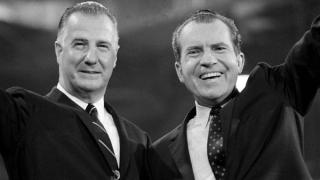Governor Nelson A. Rockefeller of New York moved to the lectern. It was the Cow Palace in San Francisco in the summer of 1964 and the event was the Republican National Convention. Rockefeller was the acknowledged leader of the liberal wing of the party and as such was loathed by the supporters of the front runner for the Republican nomination for president that year: Senator Barry Goldwater (Republican, Arizona). The convention was tense and the debate over the platform heated.
In this engaging book, the authors focus on the moment when the seismic plates in the Republican party base shifted.
A proposed platform plank denouncing extremism, supported by the party’s Eastern wing, was debated fearlessly and ultimately defeated, but not before Rockefeller himself was booed and heckled by Goldwater supporters as he attempted to speak in favour. “This is still a free country, ladies and gentlemen,” Rockefeller lectured the hostile crowd before decrying the “communist and Nazi methods” of the Goldwater campaign. The moment was symbolic as the ground shifted beneath the party’s foundations.
American politics were about to change irrevocably. The tremors are still being registered.
The foundations which constitute the Republican party’s base did not stop shifting between 1964 and 2016, during the time of Richard Nixon’s election in 1968 through Ronald Reagan’s elevation to the White House in 1980, courtesy of the ‘Reagan Democrats’ and certainly continuing through Donald Trump’s victories in the Midwest and the upper Midwest in November 2016.

The professorial authors argue convincingly that it is not possible to understand Donald Trump’s victory without reference to the ‘Silent Majority’ so beloved of Nixon. And the figure most closely identified with inspiring the Silent Majority at the ballot box in both 1968 and 1972 remains Spiro T. Agnew.
Agnew had a brief career in Maryland politics at local and state levels, until being tapped by Nixon to be his Vice President at the Republican convention in Miami Beach in 1968. Agnew had risen to be the Republican governor of Maryland in a traditionally Democratic state, riddled with corruption. He had caught Nixon’s eye for an aggressive stance which he had taken on racial strife. The black militant H. Rap Brown had visited Maryland, making incendiary remarks about shooting ‘honkies’ and burning cities. Agnew had been a moderate among Maryland politicians on racial issues, even supporting the desegregation of a local amusement park. But he sensed the opportunity in Brown’s inflammatory rhetoric. And at a meeting of African American Civil Rights Leaders, he struck. Agnew caused a walkout by denouncing those leaders in the African American community who had failed to condemn Brown.
1968 was a time of political and social turmoil in America. The insightful Republican commentator, George F. Will, points to the consequences of the Tet offensive in Vietnam, which shook American confidence to its core and the dreadful murders of Dr Martin Luther King and Senator Robert F. Kennedy. Many campuses were aflame and Middle America wanted a reaffirmation of traditional values. Nixon understood this all too clearly and he knew it especially important in the South. Nixon always denied that he had a ‘Southern Strategy’ but he set about working with Senator John Tower (Republican, Texas) and Senator Strom Thurmond (Republican, South Carolina) to build a bridge to white working class voters who were traditional Democrats. Both Tower and Thurmond had left the Democratic party due to its commitment to civil rights as reflected ultimately in the Civil Rights Act (1964) and the Voting Rights Act (1965).
Into this volatile political mix stepped Governor George Wallace of Alabama, an outspoken and rancid segregationist. Nominally a Democrat, Wallace ran for President in 1968 and the Republicans needed an effective response. Spiro Agnew fit the campaign bill perfectly. As Vice President, Agnew became the Administration’s combative ambassador to the Silent Majority.
He became the Republican Party’s point-man in an emerging cultural war on issues of class, race, and morality that would become a staple of American politics for the next half century. While the slashing rhetoric of his public crusades and speeches made him a household name, he also put forward a bold, more populist vision for the party.
Agnew was ably assisted by Nixon’s speechwriters Pat Buchanan and William Safire. His rhetorical flourishes included attacks upon liberal elites in the media and academia, which still characterise the Trump playbook today, although one doubts Donald Trump would ever denounce critics as ‘the nattering nabobs of negativism’.
This book offers an informed assessment of American political culture over the last half century. Significantly, among the first people to recognise Trump’s appeal was Mrs Pat Nixon, who saw Trump on television in New York in the 1980s. This produced an encouraging letter from the former president to the aspiring politician.
This book is not without humour. At the Republican National Convention, again in Miami Beach in 1972, Agnew suggested that the famous media psychologist Dr Joyce Brothers should support his nomination for Veep. Senator Tom Eagleton had been forced off the Democratic ticket as Senator George McGovern’s running mate, due to treatment for mental illness.When told of Agnew’s creativity, Nixon snarled and asked did Agnew want to prove that he was not ‘nuts’ like Eagleton.
Nixon and Agnew were never close personally. This probably saved Agnew from destruction in the Watergate scandal. Despite his value to the Republican party, Agnew was always distant from the White House and while he fell from grace as a result of personal corruption, his words still reverberate throughout the Colosseums of the culture wars.
Republican Populist traces the emergence of the dramatic shift in America from Goldwater to Trump. It is argued with clarity and a confidence which renders the book significant. As Trump heads out for his next rally, no doubt the spirit of Spiro Agnew will be with him on the dais.
Republican Populist: Spiro Agnew and the Origins of Donald Trump’s America
by Charles J. Holden, Zach Messitte & Jerald Podair
University of Virgina Press, pp.259





